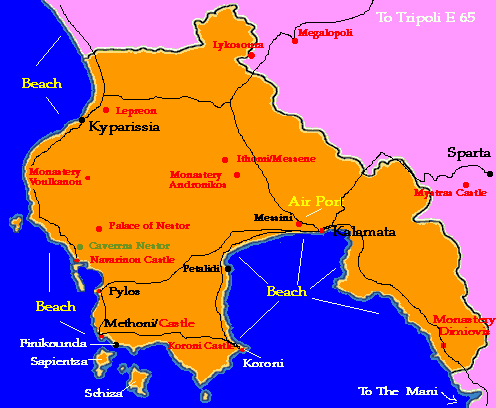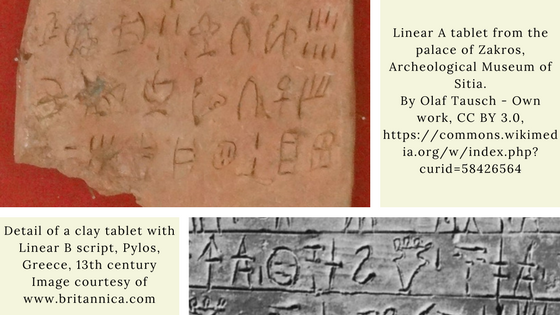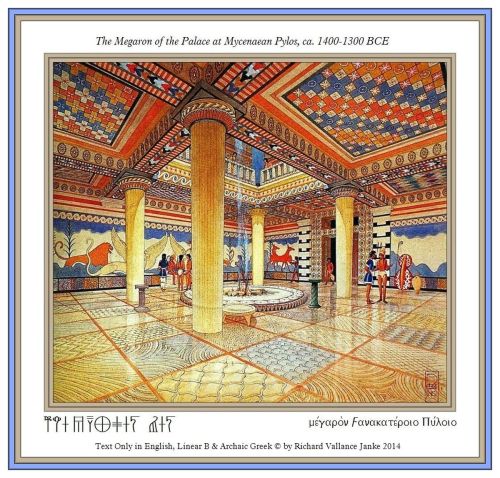In Ancient Greece, family trees are more diverse than modern zoos and following in the footsteps of heroes can be quite confusing when searching for familial clues. Much like Theseus retracing his steps out of the labyrinth, it’s often a process of grabbing a thread and following it wherever it leads.
Fulfilling the role of Ariadne, this guest post is from historical fiction novelist Luciana Cavallaro. Luciana spins an excellent yarn, writing historical fantasy that meanders in flowing streams connecting contemporary life with the family trees of mythology and history.
Luciana’s first book, Accursed Women: A Collection of Short Stories, focuses on five famous women of ancient Greek mythology: Hera, Helen, Medusa, Pandora, and Phaedra. Luciana’s second book, Search for the Golden Serpent, is destined to be a very exciting series covering the early days of Ancient Greece, before the rising civilization was even known as Greece.
Here’s a short description of Search for the Golden Serpent:
It’s not where he appears, it’s when. What if you’re born during another time, grew up in the 21st century and then were thrust back into the past? Confused? So is architect, Evan Chronis. Evan, drawn by screams, ventures out to his backyard and sees blood trickling down the limestone stairs. He steps off the veranda and finds himself in the days of great and marvellous power, a time when the gods ruled the universe. To return to the 21st century life he longs for, he must risk his life in search of powerful, treasured relics older than the Holy Grail. But what he finds might be more than he expected. Will Evan find the relics and return home or will he remain forever stuck in a world so different from his own?
With loads of great reviews on many websites, Search for the Golden Serpent is clearly not just another pretty myth. I’m not only convinced that it needs to be in my hands NOW, I’m completely captivated, so I’ve ordered my copy and I’m impatiently waiting to receive it.
Just to whet your appetite, here are a few Amazon reviews that helped convince me:
“Search for the Golden Serpent is a historical, mythological, fantasy quest on an epic scale.”
“I highly recommend reading this novel that not only whisks you away into adventure, but it also vividly shows the mystique of ancient civilizations and religions. This novel is particularly a delight for those who love mythology and the hero’s adventure.”
“This story is beautifully written, the scenes rich and vividly choreographed, the characters and places intricately and beautifully detailed. You get the sense you are along for the ride on this Odyssey, and you had better hang on.”
“Luciana Cavallaro’s passion for ancient history reflects in her vivid descriptions of ancient times and its people. The high-stakes narrative moves forward with momentum and the story arcs grow and intersect in satisfying ways.”
I clearly have to catch up because, posting on her official website, Eternal Atlantis, Luciana has recently started a new series of blog posts continuing the events at the end of Search for the Golden Serpent.
At any rate, this is a great starting point to either continue on in the journey or jump in fresh.
Starting Point – A Great Place to Start
“…the Sun leapt up into the brazen firmament to bring light to the immortals
and to mortal men on the fruitful earth.
The travellers now came to Pylos, the stately citadel of Neleos….”
[Homer, Odyssey 2:1-4]
Starting Point
Originally published on Eternal Atlantis
by Luciana Cavallaro
To begin the new series, we are starting at the city of Pylos, from where the characters resume their search for the sacred relics of the Mother Goddess.
The ancient site of Pylos was a Mycenaean city in southern Greece, established in the bronze-age, circa 1,300 BCE. Its location on the western coast in the Peloponnese, facing the Ionian Sea and the Italian coast, enabled the city to become a trading port.

According to mythology, a man called Pylas, who came from Megara, settled in the ancient area of Messenia and was later expelled by Neleus. Neleus and a group of Pelasgians came from Iolcos in Thessaly, once home to Jason, as in ‘Jason and the Argonauts.’ Pelias, Neleus’ brother, exiled him for some reason, (none has been given in any of the references used or searched) (Vail’s note: learn more, below*) and hence he and the Pelasgians head for Messenia and make Pylos their home. King Nestor was one of Neleus’ son.
In 1939, archaeologist Carl Blegen, arrives at the site in search for the famous city of Pylos and in particular, Nestor’s palace. During his excavations, he uncovers a vast site on the hilltop where evidence of extensive structures emerge and shards of Mycenaean pottery. In his investigation, Blegen discovers the building/s had been occupied during the era of the Trojan War, circa 1,300 BCE. He also uncovered numerous tablets written in Linear B, a script used by the Myceneans, an adaptation of Linear A, which was first invented by the Minoans.

Links between Homer’s Iliad and the tablets provided enough evidence for Blegen to suggest Pylos was indeed the city referred to by Homer.
The contingent from Pylos came from there and from lovely Arene; from Thryon, where the River Alpheus is forded; from handsome Aepy; from Cyparisseis, Amphigeneia, Pteleus and Helos…
[Homer, Iliad 2:591-594]
The other interesting feature about Mycenaean palaces was how much they resembled Minoan palaces. The Minoans were a seafaring power with extensive trading partners. To read more, click here to go to blog post. Following the decline of the Minoan civilisation, Mycenaean artwork, architecture, jewellery, female deities and script showed a strong Minoan influence. There is an interesting article by NY Times that discusses the connection between the Minoans and Mycenaeans.

Artist’s reconstruction of the palace
http://proteus.brown.edu/greekpast/4870
References:
Bury, J.B. and Meiggs, R. (1975). A history of Greece. Palgrave. Hampshire. pp31-33
Pylos https://www.varchive.org/dag/pylos.htm
The Pylos Palace Mycenaean Civilisation http://www.greek-thesaurus.gr/Mycenaean-Pylos-Palace.html
——————————————
*Notes on Pelias, Neleus, Nestor, and Pylos:
Neleus and Pelias are twin sons of Poseidon and Tyro. Tyro is the daughter of Salmoneus, King of Elis in the Peloponnese. At the time she lay with Poseidon (thinking he was the river god Enipeus), Tyro was married to Cretheus, the founding King of Iolcos in Thessaly. From Cretheus she gives birth to Aeson (the father of Jason of Jason and the Argonauts), Pheres, and Amythaon.
“But she (Tyro) conceived and bore Pelias and Neleus, who both became strong servants of great Zeus; and Pelias dwelt in spacious Iolcus, and was rich in flocks, and the other dwelt in sandy Pylos. But her other children she, the queenly among women, bore to Cretheus, even Aeson, and Pheres, and Amythaon, who fought from chariots.”
[Homer, Odyssey 11.254]
Neleus and Pelias are abandoned at birth on a hillside in Thessaly by their mother but are saved and raised by a horse-keeper (alternatively a herdsman or a maid). Reaching adulthood, the two brothers go in search of their real mother. Upon finding her suffering from abuse by her stepmother, Pelias kills his stepmother in a temple of Hera, thus earning him Hera’s undying hatred.
Soon after this, Pelias beats Neleus in a fight over their (step)father’s kingdom, and Neleus is subsequently banished to Messenia in the Peloponnese. Pelias goes on to become the infamous murderer of Jason’s family and initiator of Jason’s quest for the golden fleece, which ultimately results in Pelias’ death and Jason’s miserable married life.
Neleus’ maternal cousin Aphareus, King of Messenia, gives him a parcel of land on the seacoast (which may or may not have been previously settled by Pylas, King of Megara, who was exiled from Megara after killing his father’s brother Bias).
Quickly dispatching Pylas, or not, as the case may be, Neleus settles in and establishes his palace, eventually becoming the King of Pylos. Marrying Chloris, Neleus fathers Pero, Periclymenus, Alastor, Chomius, and Nestor.
Along with many other fathers-to-be of Trojan War heroes, Nestor participates as one of Jason’s famed Argonauts.

Attic Red-Figure Calxy Krater ca. 460-450 BCE depicting Heracles and the gathering of the Argonauts. Source: Wikimedia Commons
While away visiting relatives, Nestor becomes the only survivor after Herakles (who was also an Argonaut) kills Nestor’s father and all of his brothers when Neleus refuses to cleanse Herakles of a blood-debt.
Marrying Eurydice of Pylos, Nestor fathers Peisistratus, Thrasymedes, Pisidice, Polycaste, Perseus (son of Nestor), Stratichus, Aretus, Echephron, and Antilochos.
Allied with Agamemnon, Nestor and his sons Antilochos and Thrasymedes participate in the Trojan War. Throughout the war, Nestor is a highly respected elder captain, often providing wise advice to Achilles. His son, Antilochos is also close friend of Achilles and Patroklos, taking over as Achilles’ charioteer after the death of Patroklos.

Achilles gives Nestor the prize for wisdom at the funeral games held in honor of Patroklos during the Trojan War. By Joseph-Désiré Court, ca. 1820. Source
When Memnon attacks Nestor, Antilochus sacrifices his own life to save his father. So soon upon the heels of avenging Patroklos’ life with the death of Hektor, Achilles includes the life of Antilochos in his epic martyrdom. In his final blaze of glory, Achilles drives the Trojans back to the towering gates, where he is fatally cut down by the arrow of Paris guided by the aim of Apollo.
Although wizened old Nestor arrives safely back home to his palace in Pylos, the bones of his son remain behind at Troy.
The ashes of Achilles, Patroklos, and Antilochos are eternally enshrined together in a burial mound on a promontory overlooking the Hellespont:
But when the flame of Hephaestus had made an end of thee,
in the morning we gathered thy white bones, Achilles,
and laid them in unmixed wine and unguents.
Thy mother had given a two-handled, golden urn,
and [75] said that it was the gift of Dionysus,
and the handiwork of famed Hephaestus.
In this lie thy white bones, glorious Achilles,
and mingled with them the bones of the dead Patroclus,
son of Menoetius, but apart lie those of Antilochus,
whom thou didst honor above all the rest of thy comrades
after the dead Patroclus. [80]
And over them we heaped up a great and goodly tomb,
we the mighty host of Argive spearmen,
on a projecting headland by the broad Hellespont,
that it might be seen from far over the sea
both by men that now are and that shall be born hereafter.
[Homer. Odyssey, 24:70-84]

Colorized version of George Sandys' The Castles Commanding y Hellespont, 1615. Source: Wikimedia Commons



Thank you for the incredible introduction, Kathleen. I really enjoyed reading your follow up post on Pelias, Neleus, Nestor, and Pylos. Beautifully written. There is so much information one could write on the mythologies, and isn’t that great 😀
Thank you again.
LikeLiked by 1 person
My pleasure, Luciana! Greetings from Egypt – sorry it took so long to respond, it was a chore getting the internet back up at the house here but I’m up and running again – enjoying a little vacation in the rural Nile Delta! ;^)
LikeLiked by 1 person
[…] Stocker, archaeologists in UC’s classics department, found the two beehive-shaped tombs in Pylos, Greece, last year while investigating the area around the grave of an individual they have called the […]
LikeLike